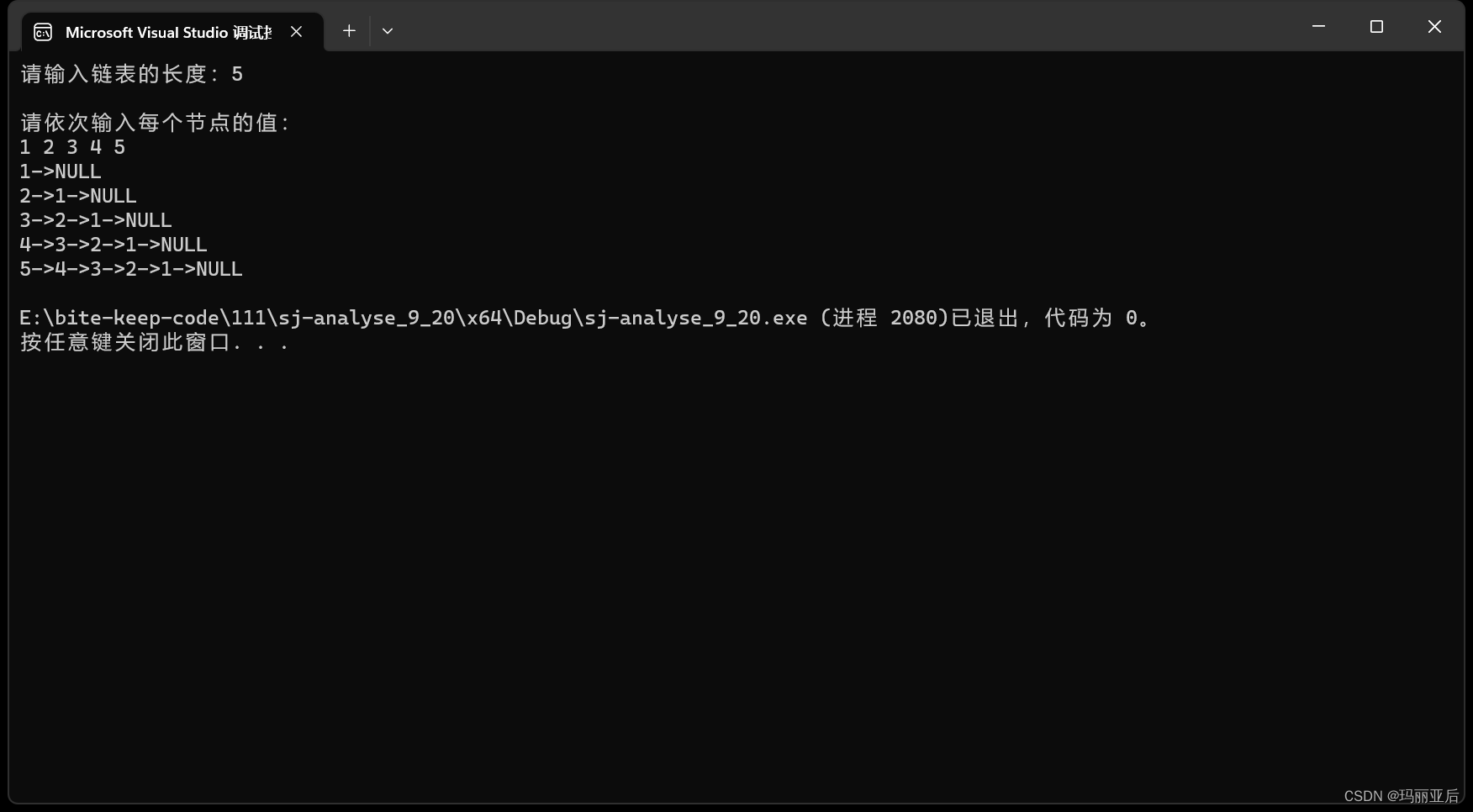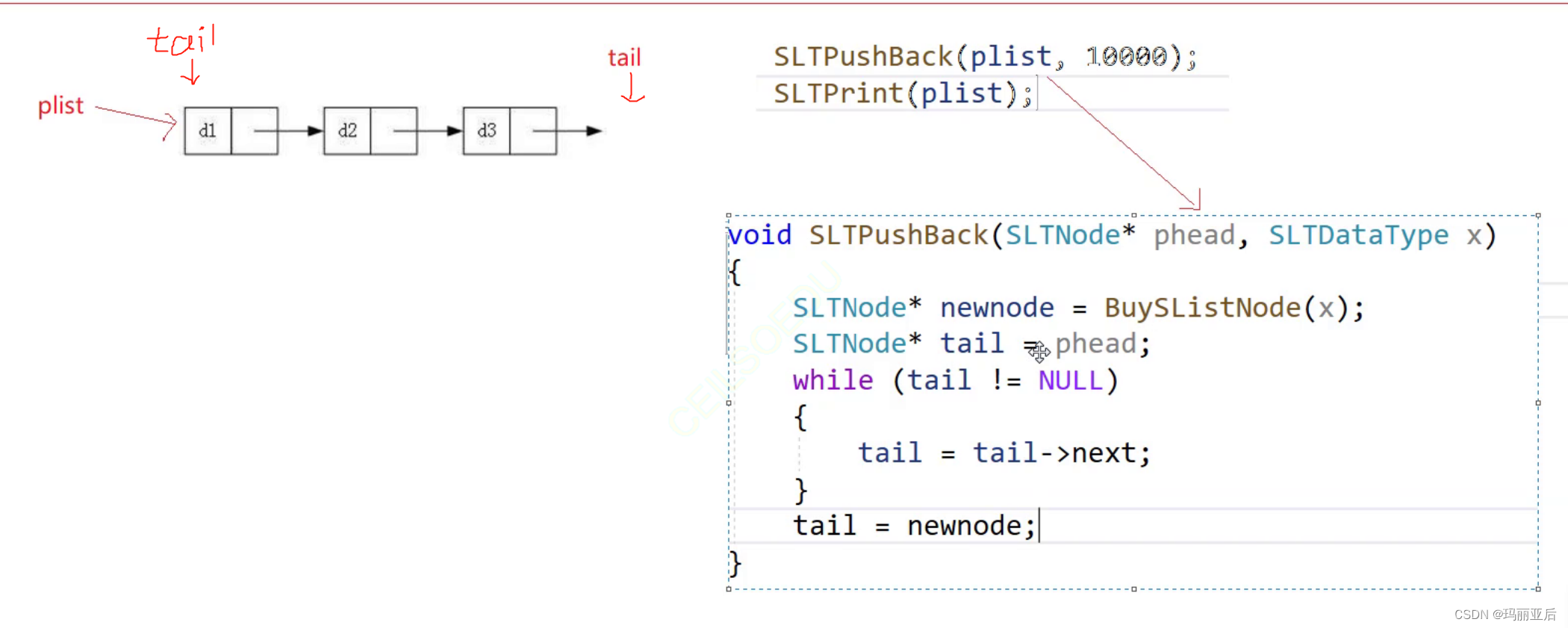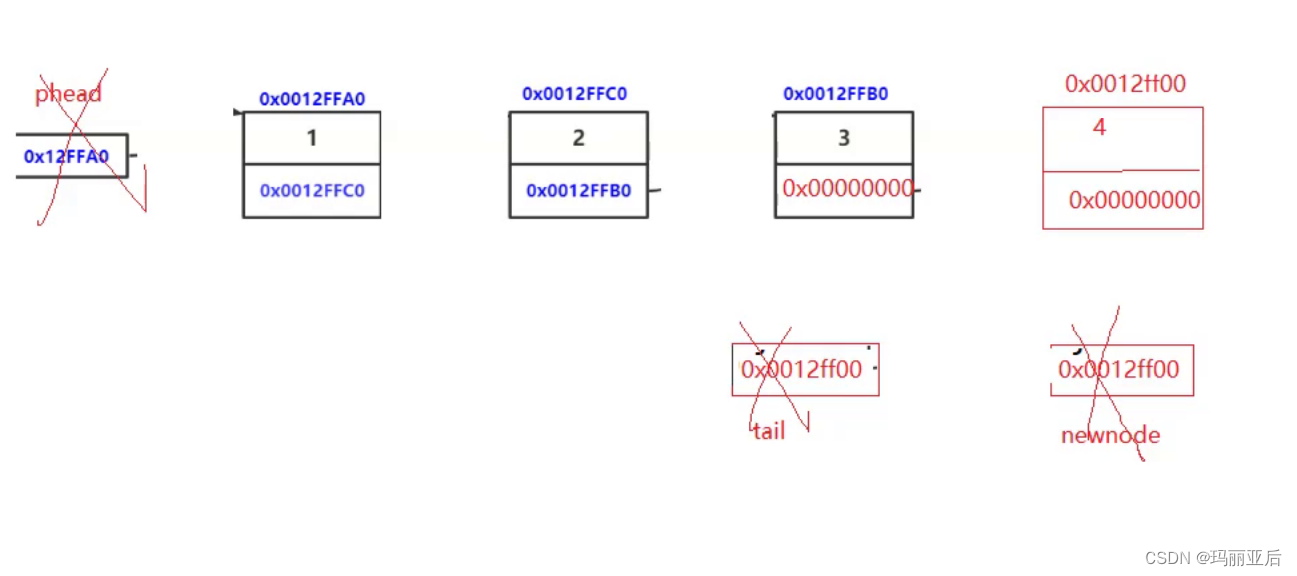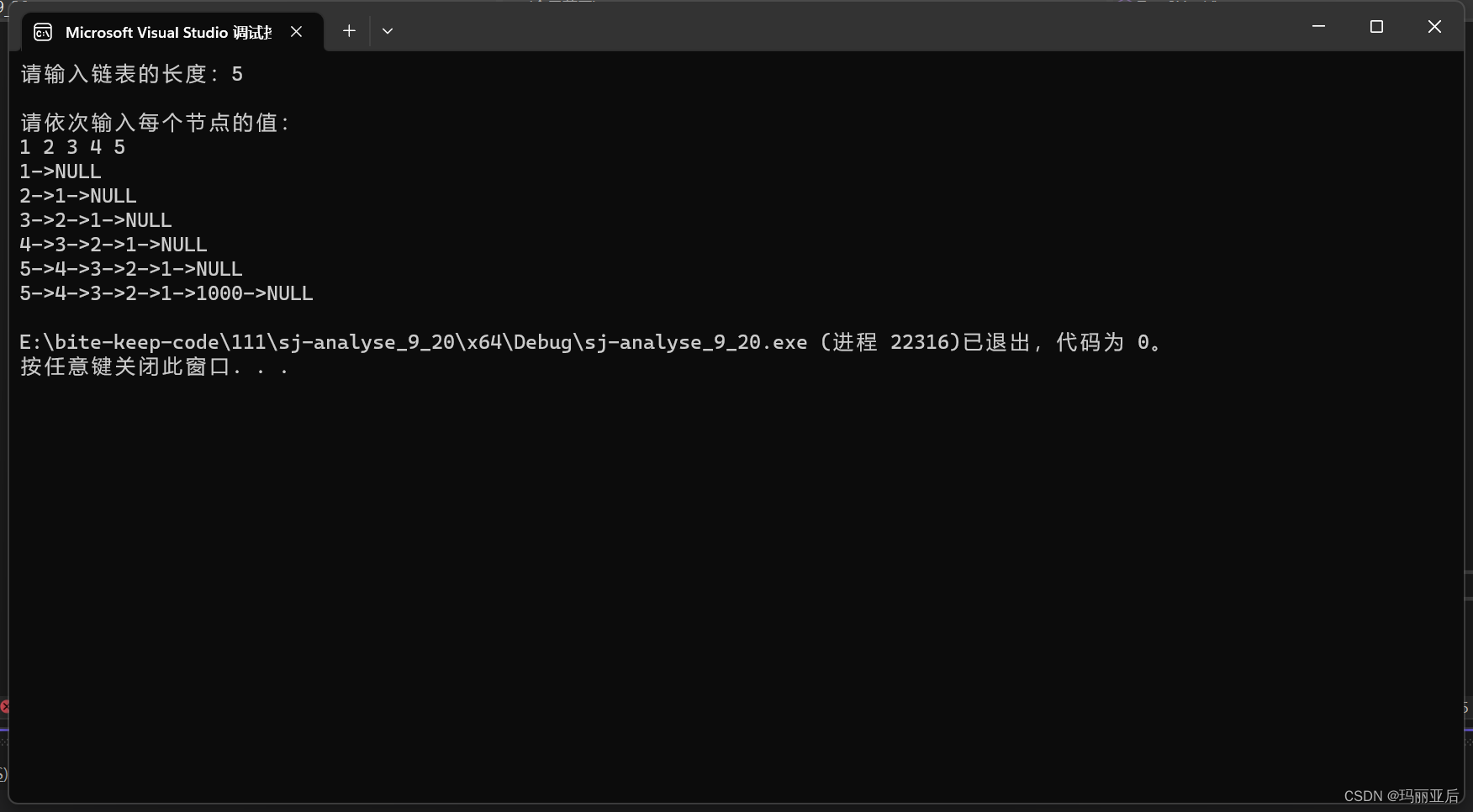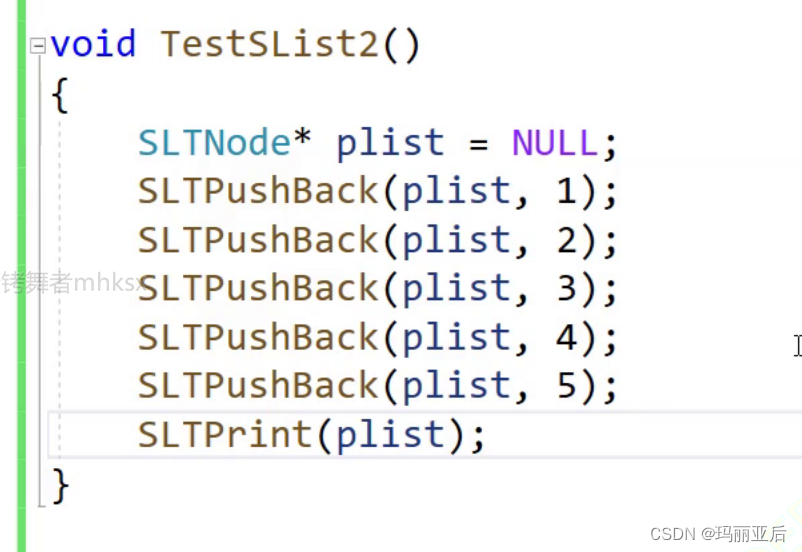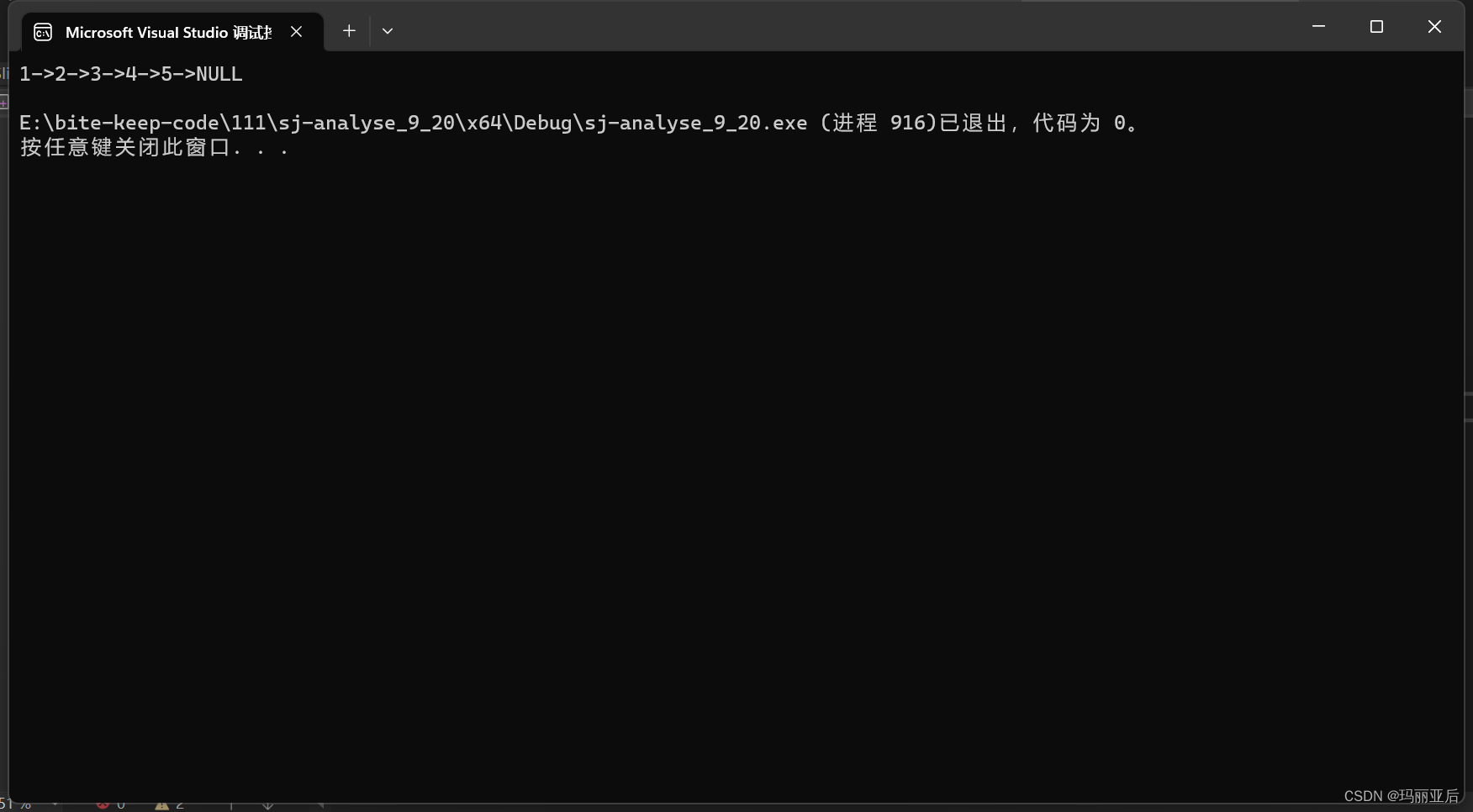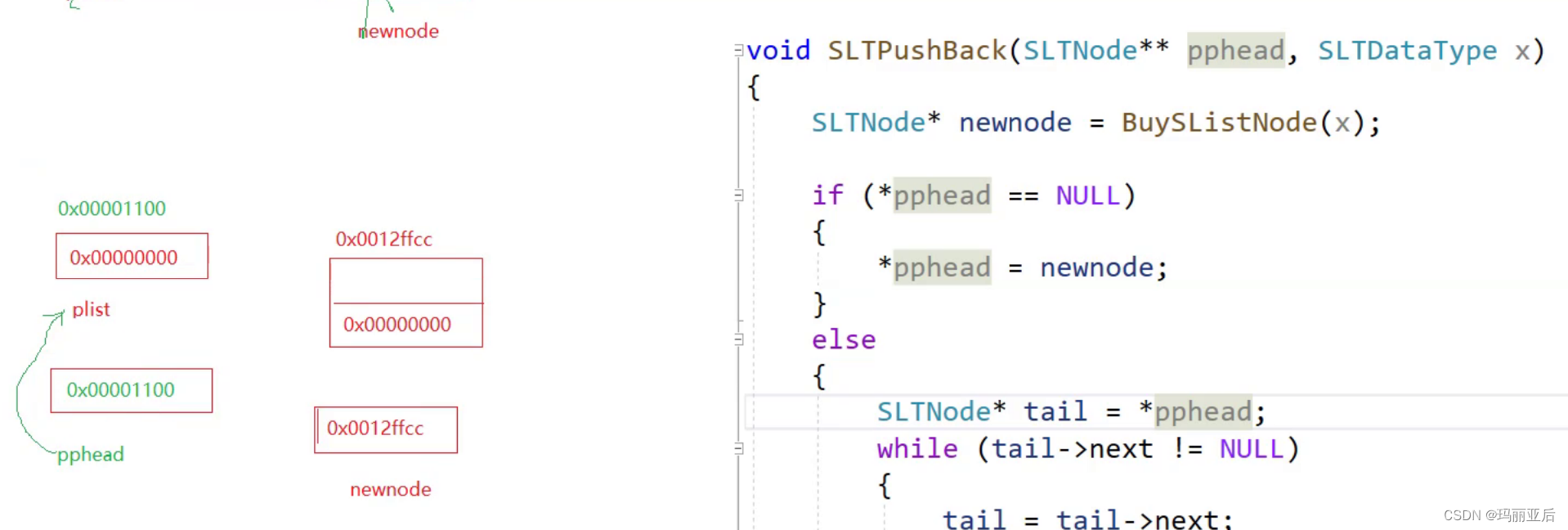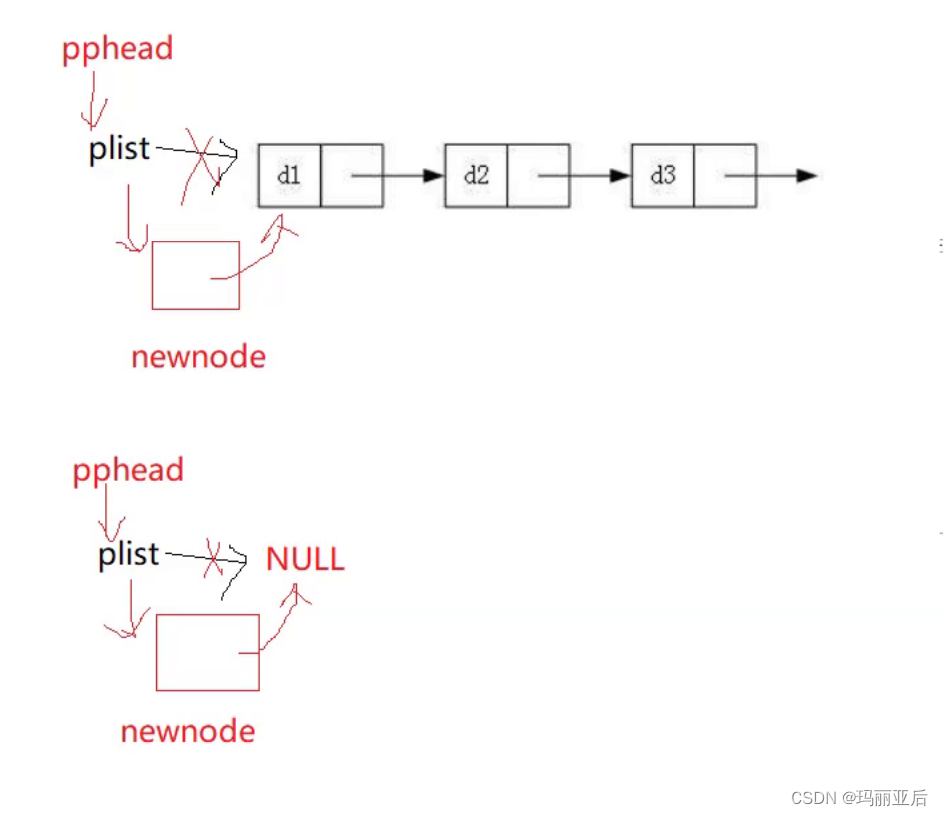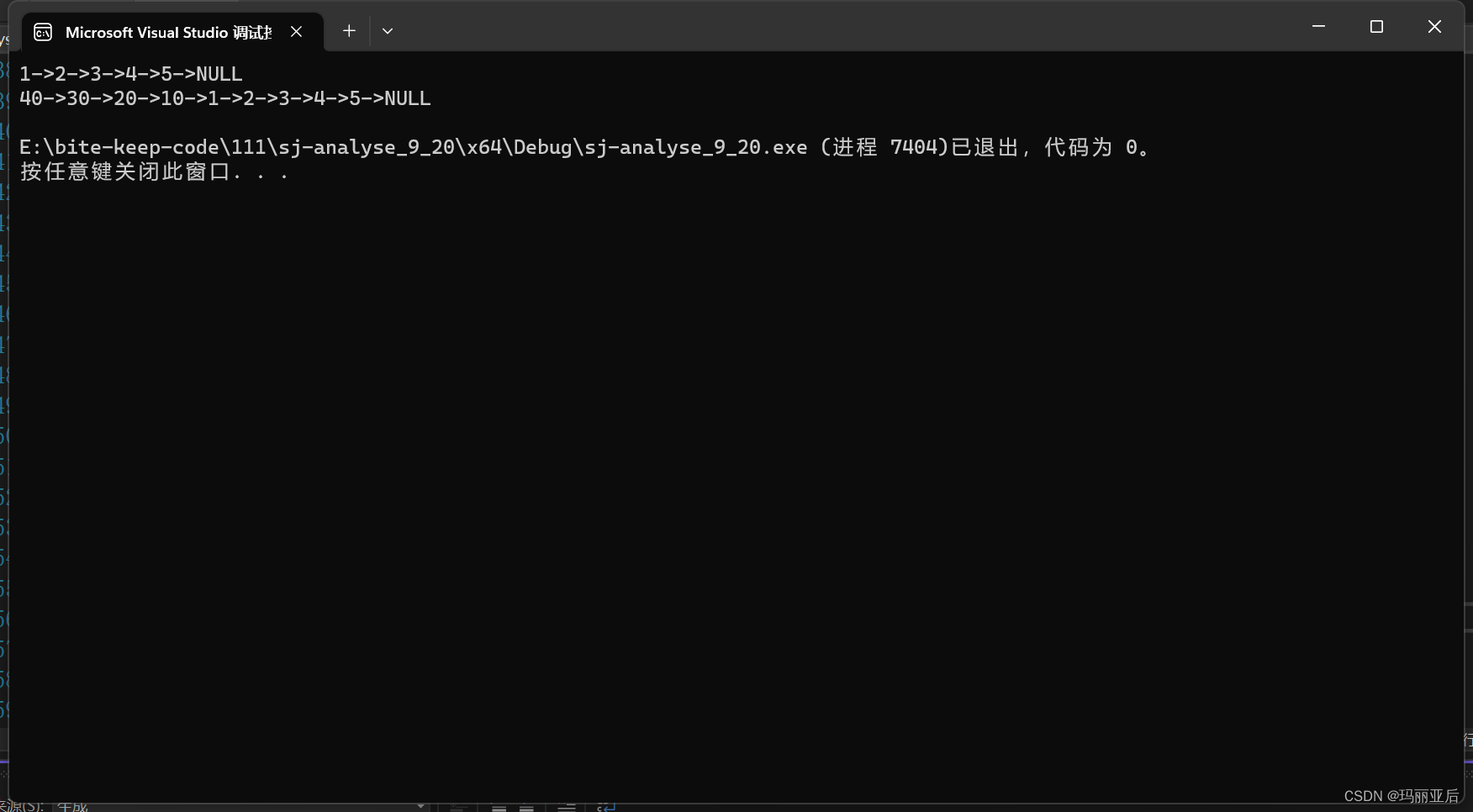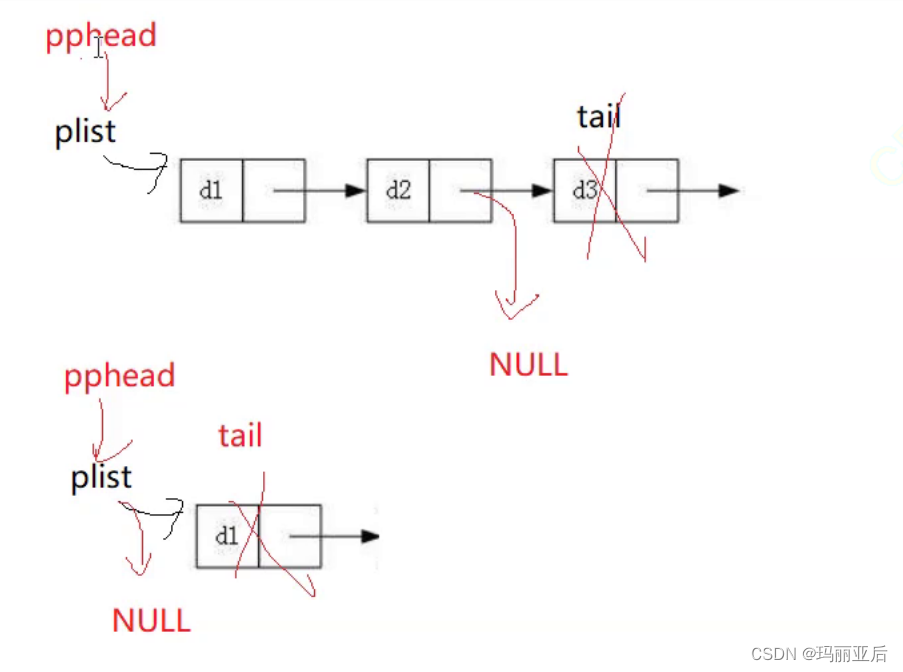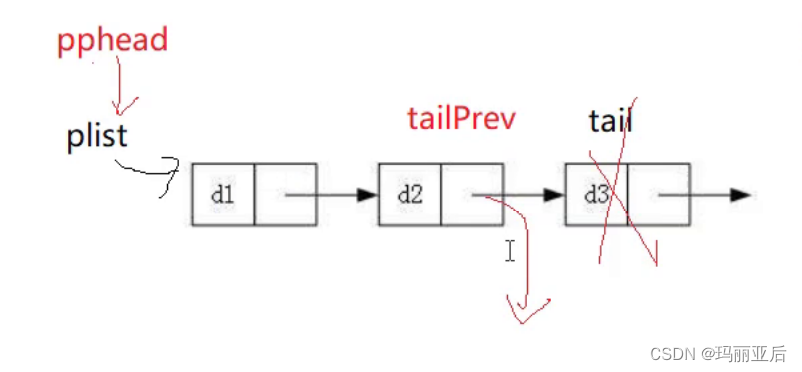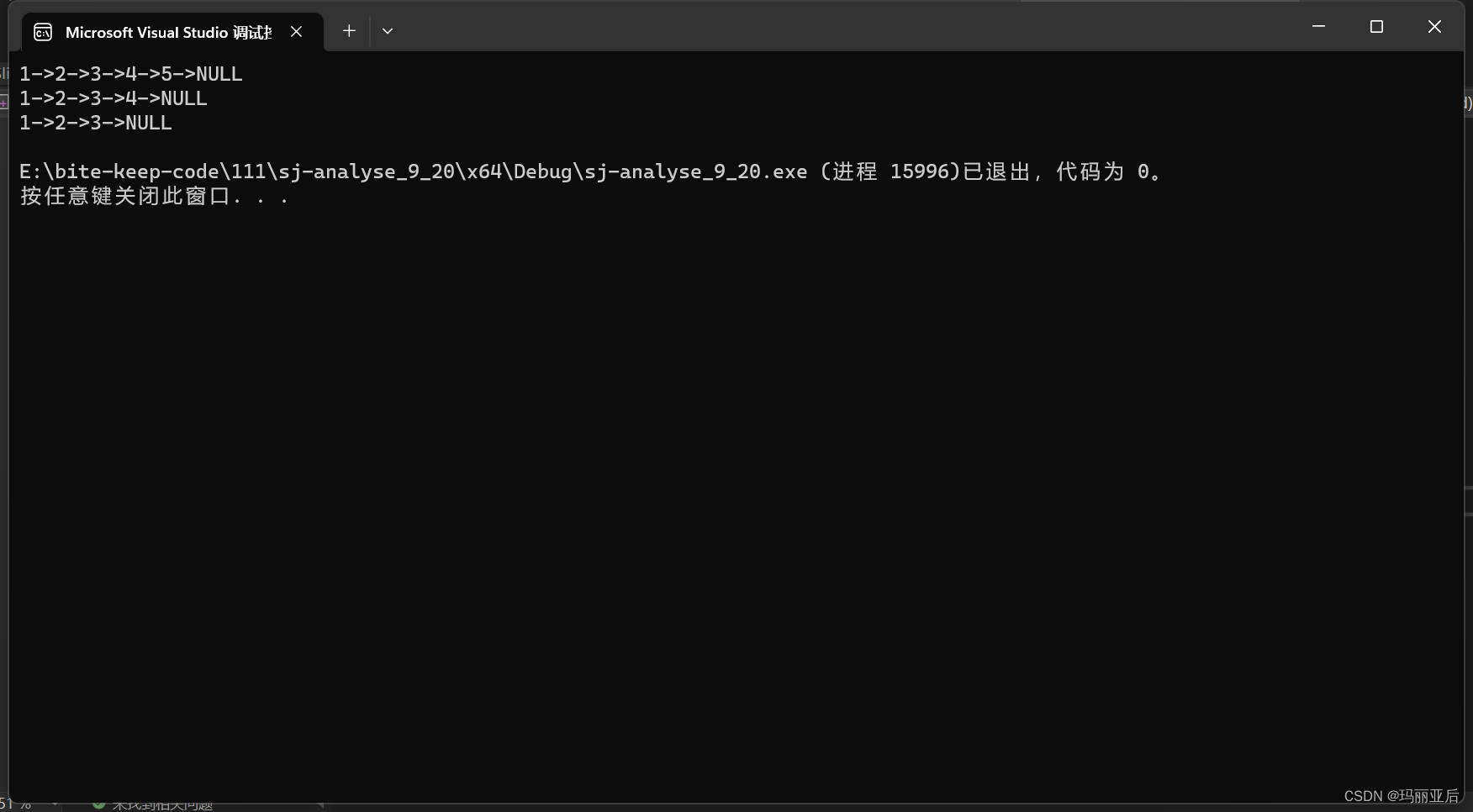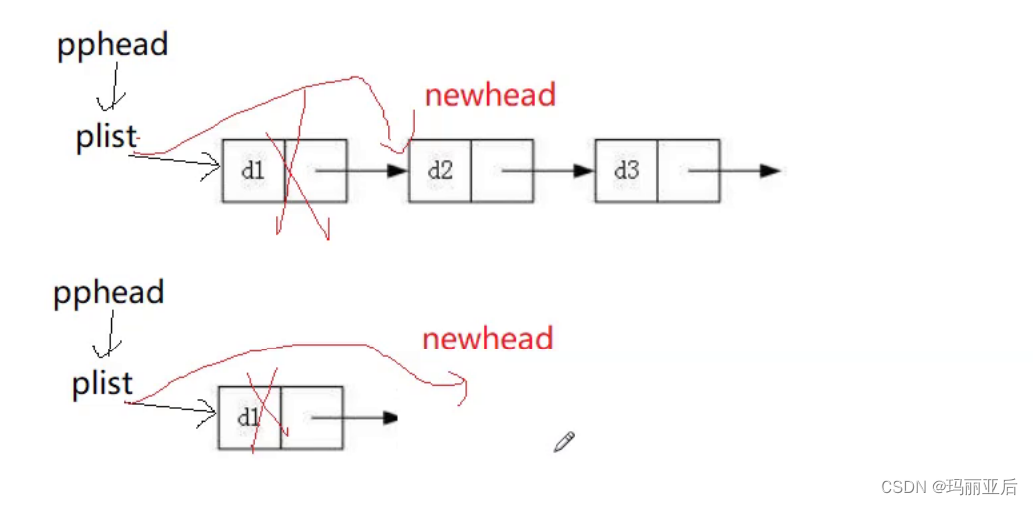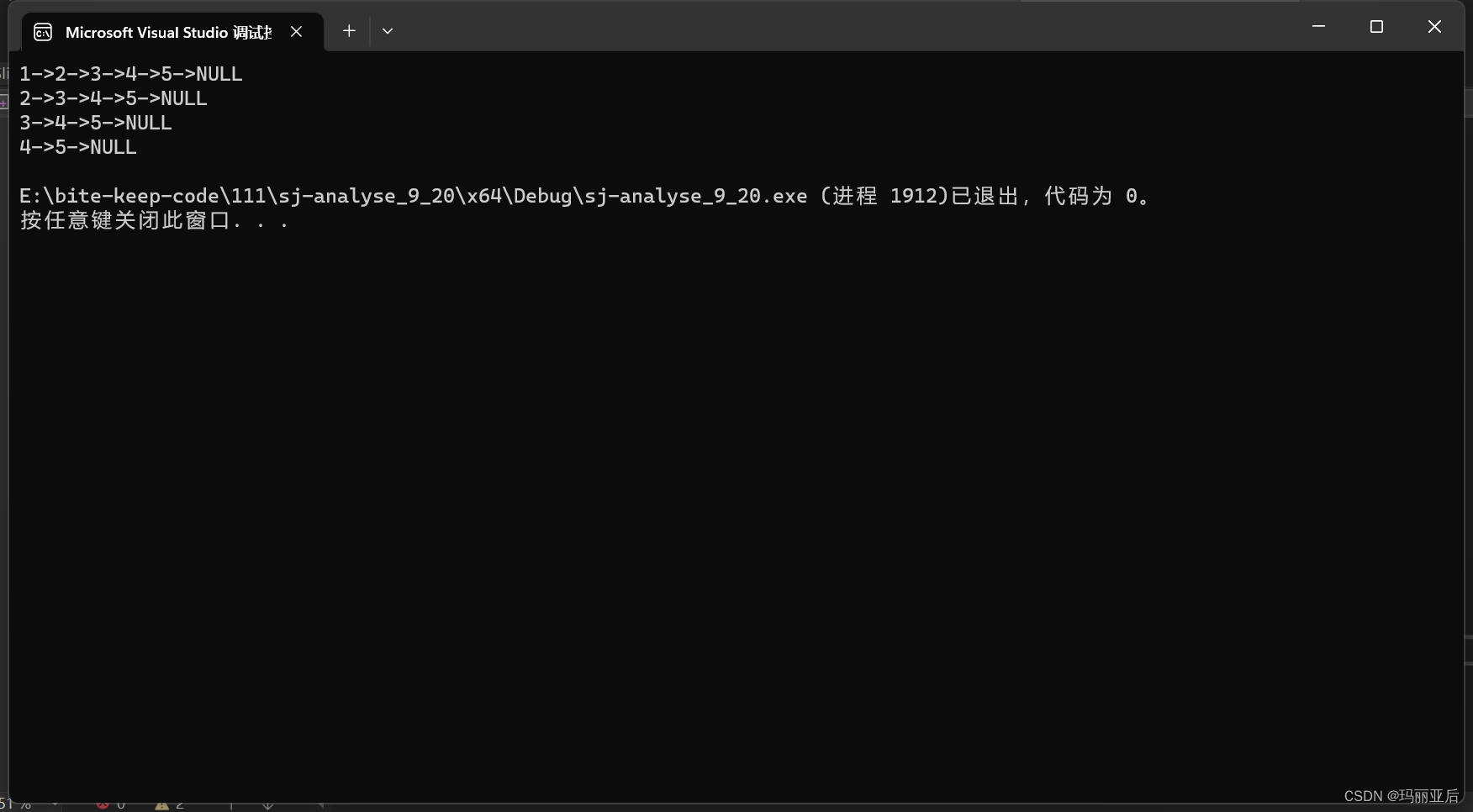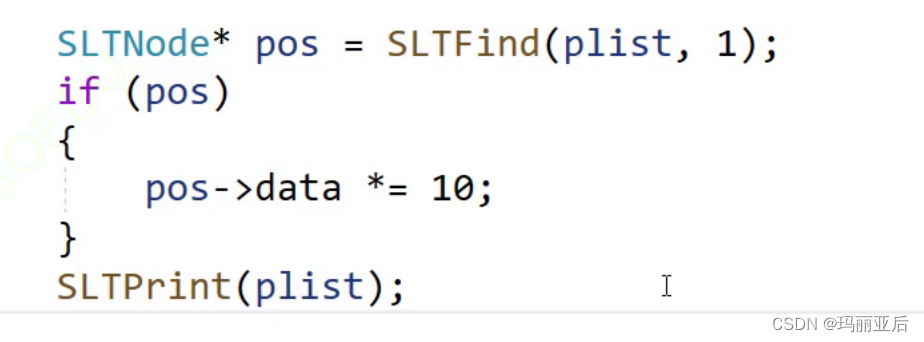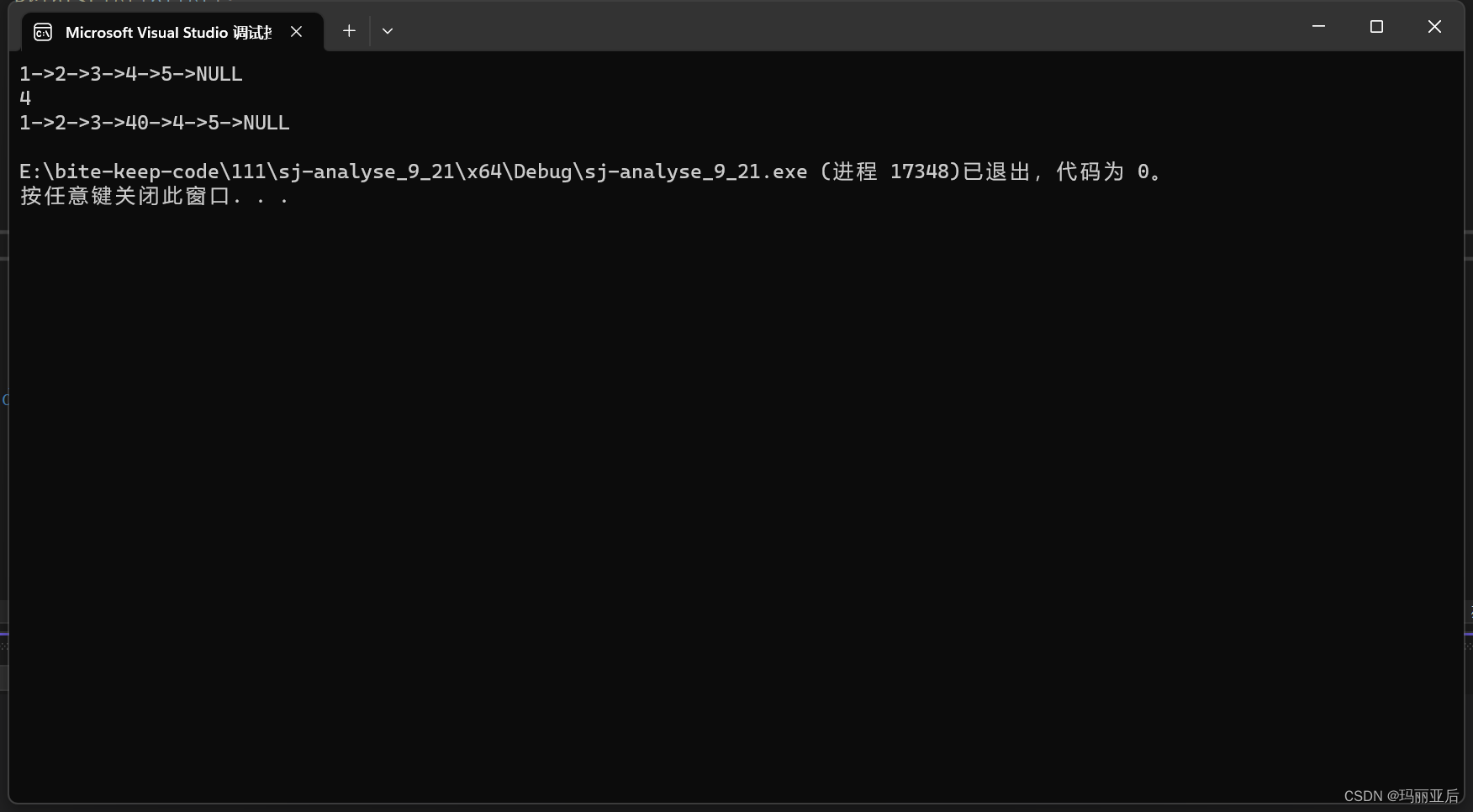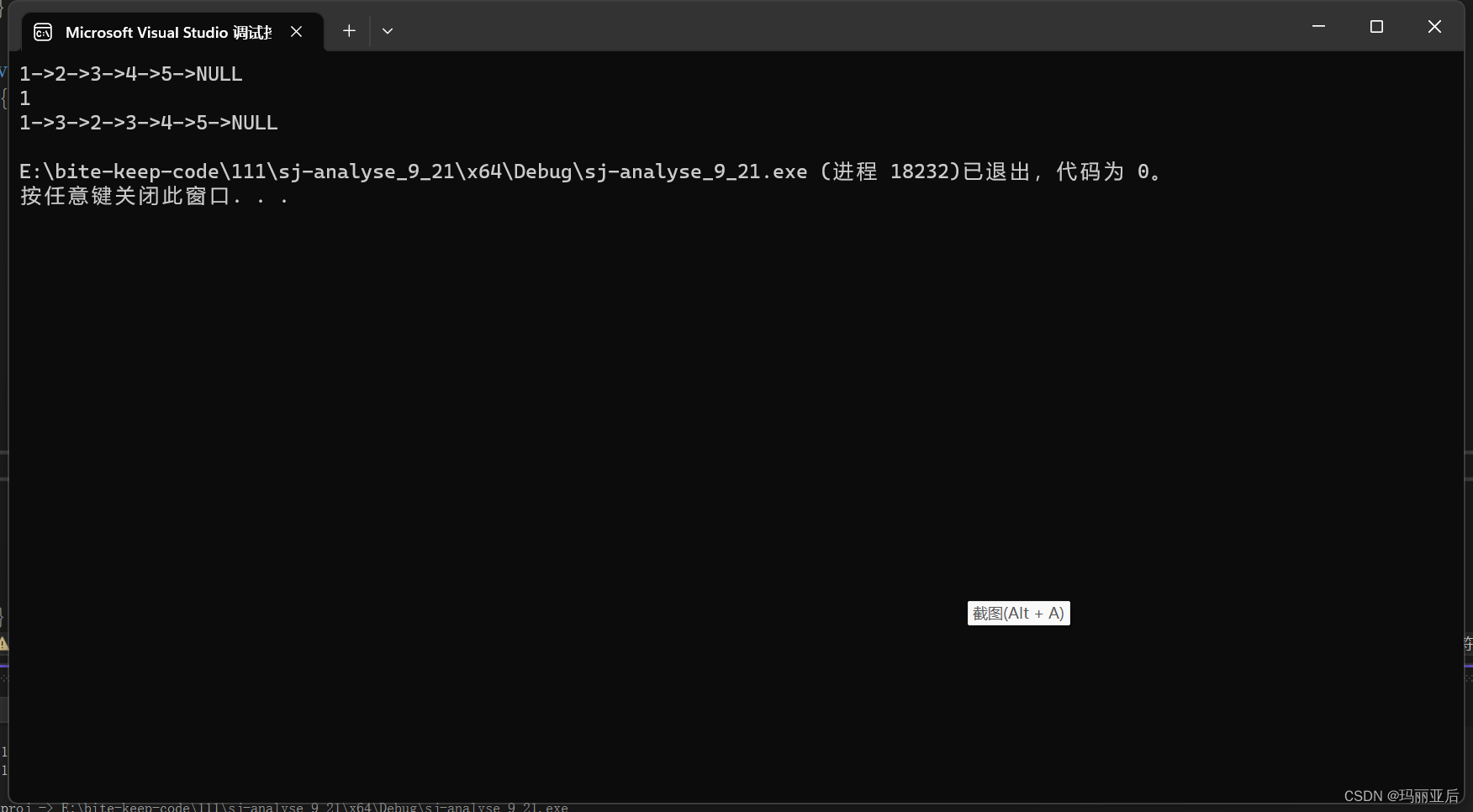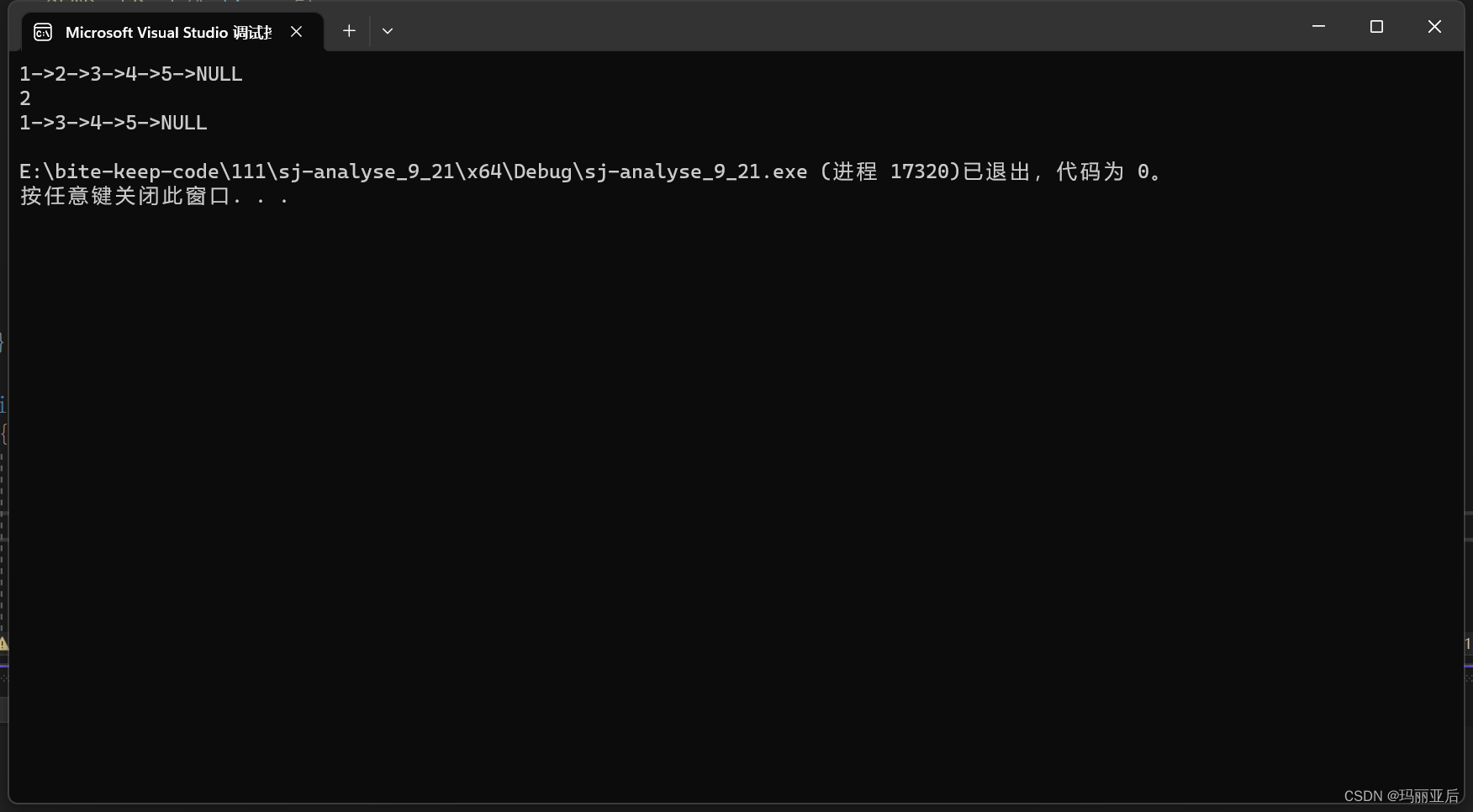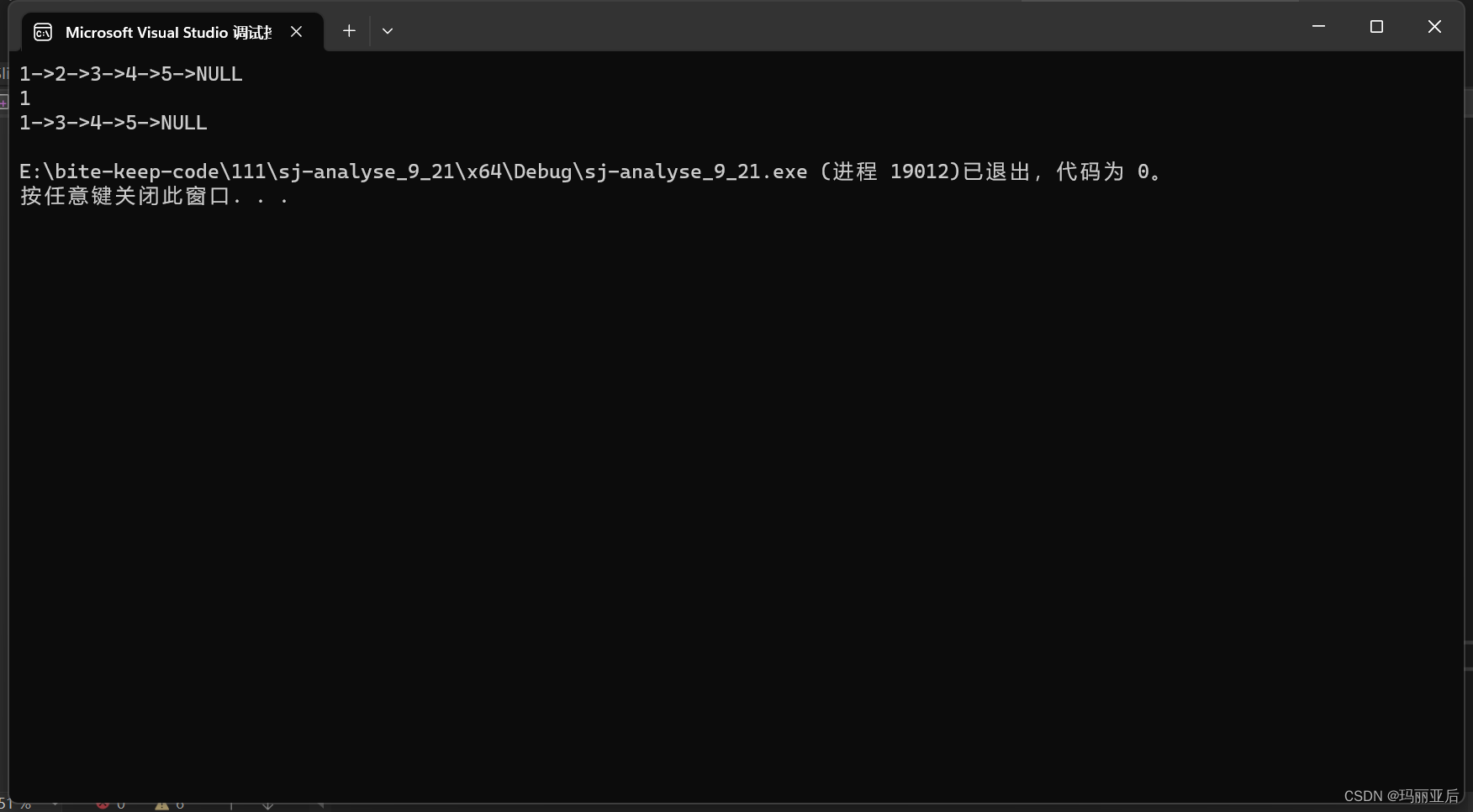
 一.前言
一.前言
超级详细的单链表分析,把这一口吃下去妈妈再也不担心孩子因为知识匮乏饿肚子了~ 码字不易,希望大家多多支持我呀!(三连+关注,你是我滴神!)
二.链表表示和实现(单链表)
1.1 顺序表的优缺点
回顾前文所说的顺序表:
缺点:
- 头部和中部插入删除效率都不行 O(N)
- 空间不够了,扩容有一定的消耗(尤其是异地扩容)
- 扩容逻辑,可能还存在空间 (比如100满了,你要插入110个数据,扩容到200就会浪费90个空间)
优点:
- 尾插尾删足够快
- 下标的随机访问和修改
1.2 链表的概念及结构

顺序表只需要知道首元素地址即可有一块连续的物理空间,并且尾部用size定义,而链表在物理空间并非连续,而是按需申请释放单个空间,空间之间用指针来相互联系。链表空间尾部是用NULL定义。
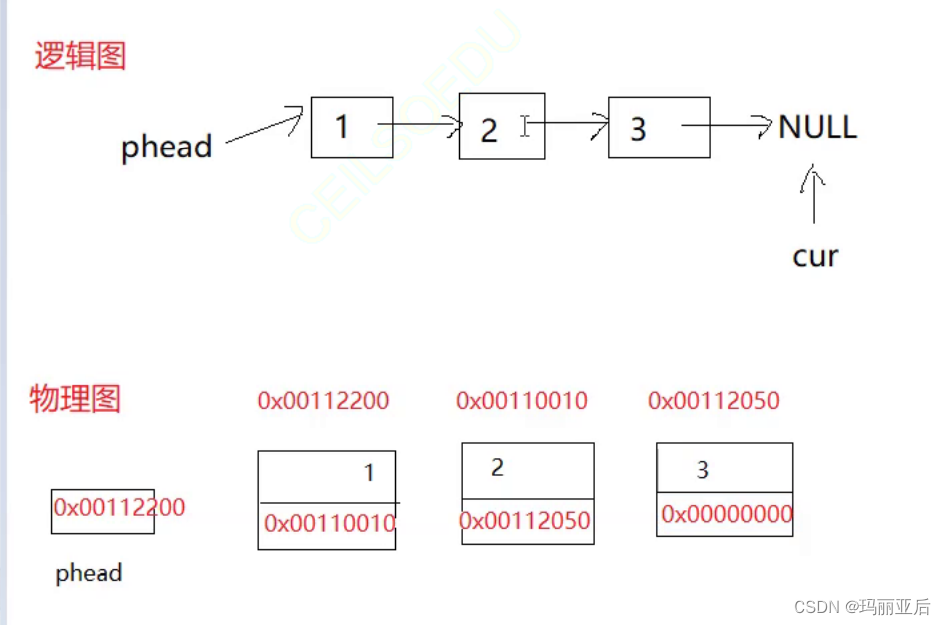
备注:由malloc出来的节点地址是随机的。
#define _CRT_SECURE_NO_WARNINGS 1
//Test.c
#include <stdio.h>
typedef int SLTDataType;
typedef struct SListNode
{
SLTDataType data;
struct SListNode* next;
}SLTNode;
int main()
{
return 0;
}
从单链表的图示我们可以知道它是有多个节点链接而成的,一个节点里意味着有一个结构体,那么我们所指向节点的指针就应该是结构体指针变量。(struct SListNode* next)
1.3 打印函数

因为phead是指向第一个节点的,所以不要轻易去改变,我们可以再创造一个指针来遍历链表。
void PrintSList(SLTNode* phead)
{
SLTNode* cur = phead;
while (cur != NULL)
{
printf("%d->", cur->data);
cur = cur->next;
}
printf("NULL\n");
}
肯定许多友友无法理解为什么 cur = cur->next;这个next明明在代码中没有明确的指向,为什么还可以去使用呢?其实在cur指向第一个节点时cur->next是去取该结构体里面next的值,而next所存储的则是下一个结构体的地址。这样使得cur去指向第二个节点。至于为什么next能够存储下一个节点的地址就是关于编译器里的汇编该做(计算机会自动识别该指令)的事情了,我们就不做过多介绍了。
接下来带大家感受一下简易链表的跑动情况;
#define _CRT_SECURE_NO_WARNINGS 1
//Test.c
#include <stdio.h>
#include <stdlib.h>
typedef int SLTDataType;
typedef struct SListNode
{
SLTDataType data;
struct SListNode* next;
}SLTNode;
void PrintSList(SLTNode* phead)
{
SLTNode* cur = phead;
while (cur != NULL)
{
printf("%d->", cur->data);
cur = cur->next;
}
printf("NULL\n");
}
int main()
{
SLTNode* n1 = (SLTNode*)malloc(sizeof(SLTNode));
//注意!这里malloc出来的节点是结构体,那么sizeof也得代入结构体的大小,
//又因为是用结构体指针接收,所以强制类型转换也要使用(SLTNode*)。
n1->data = 10;
SLTNode* n2 = (SLTNode*)malloc(sizeof(SLTNode));
n2->data = 20;
SLTNode* n3 = (SLTNode*)malloc(sizeof(SLTNode));
n3->data = 30;
n1->next = n2;
n2->next = n3;
n3->next = NULL;
PrintSList(n1);
return 0;
}
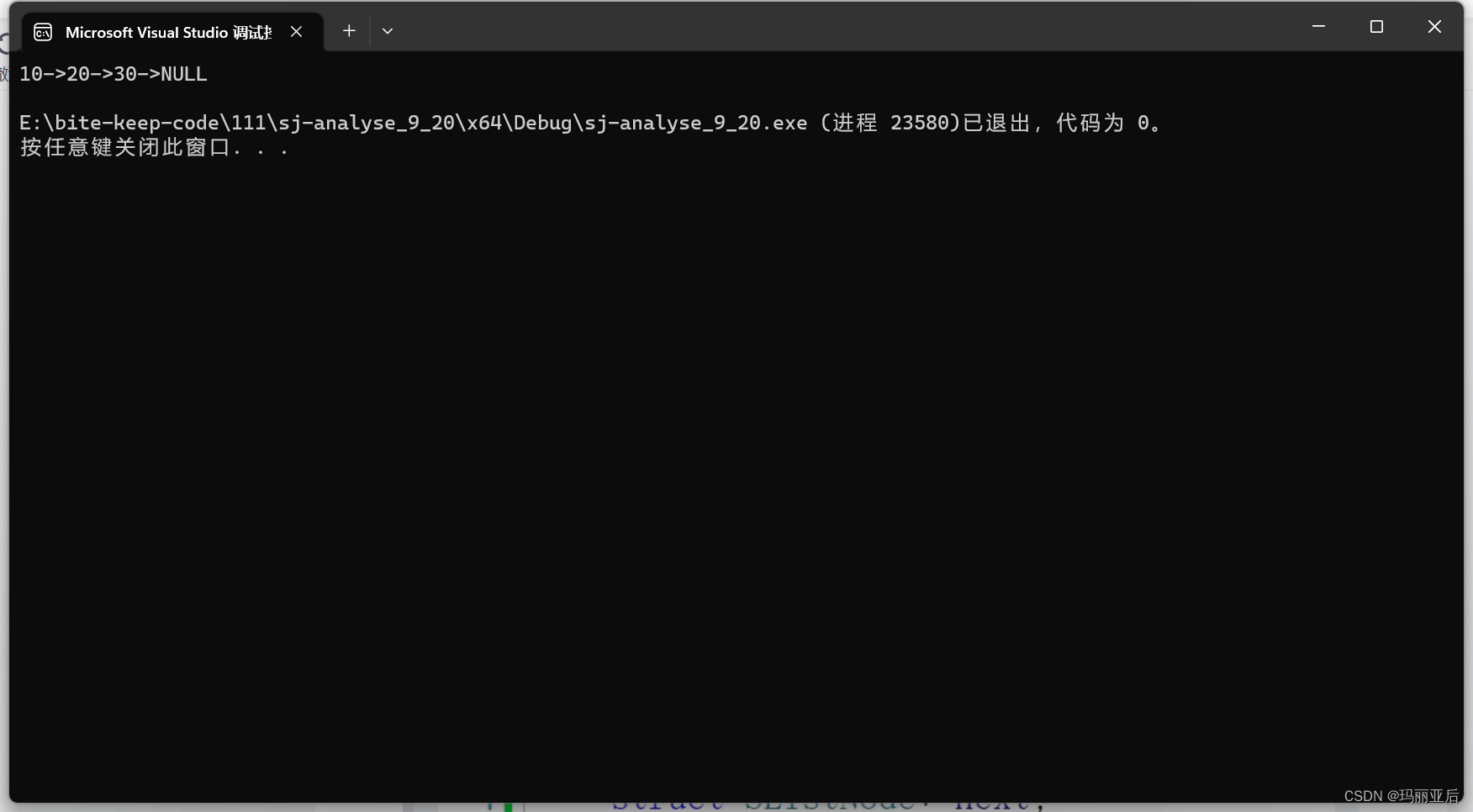
在见识到简易链表后那接下来我们就要进入真正完整结构的链表了,老规矩,先创造3个文件。
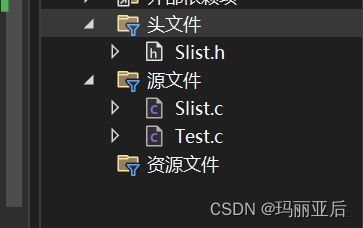
1.4 空间函数
SLTNode* BuySlistNode(SLTDataType x)
{
SLTNode* newnode = (SLTNode*)malloc(sizeof(SLTNode));
if (newnode == NULL)
{
perror("malloc fail");
exit(-1);
}
newnode->data = x;
newnode->next = NULL;
return newnode;
}
当我们创造空间函数后来进行测试:(不过会遇到一个难点,我们该如何把这些节点联系在一起呢?)
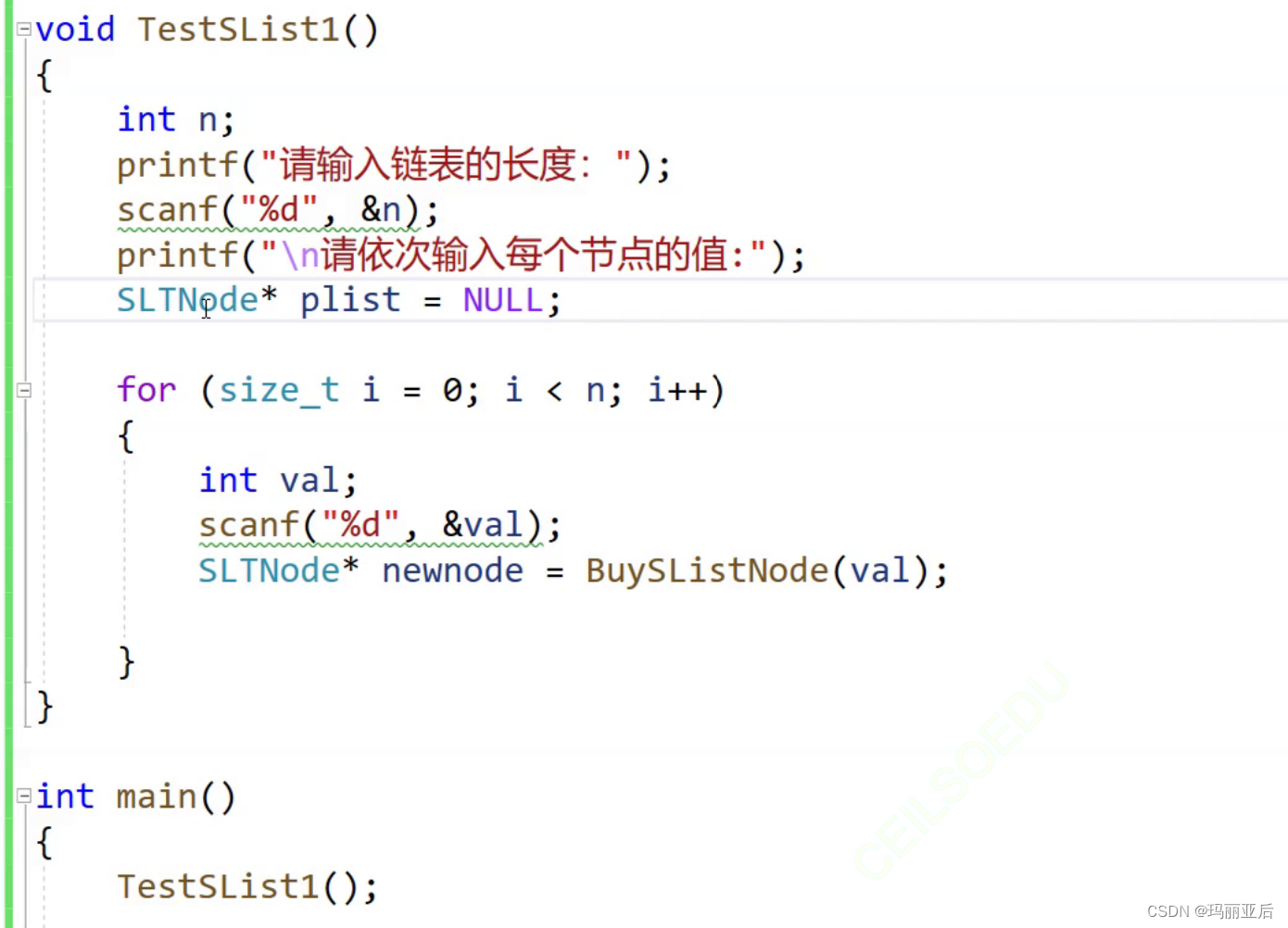 ** 这里我们提前先用头插来进行链接并且分析:**
** 这里我们提前先用头插来进行链接并且分析:**
当我们的链表不为空时,要想头插需要用newnode这个新节点将plist与plist指向的第一个节点链接起来。先将第一个节点的地址(plist所指向)交给newnode这个新节点的next处,使新节点后面链接的是第一个节点,再把新节点的地址交给plist,使plist所指向的永远都是新的第一节点。
注意!切不可交换顺序,如果先把新节点newnode的地址交给plist,那原先第一个节点就不能通过plist找到了,成为了野指针。
当链表为空时,由于plist指向的是空指针,那么当插入新节点时,plist指向就变成了新节点(第一节点),而新节点所指向的就是空指针(newnode->next=NULL)。
最后得出结论:关于头插的两句代码newnode->next = plist与plist = newnode完美契合两种情况,不需要用条件来区分开来。
** 最终测试:**
#define _CRT_SECURE_NO_WARNINGS 1 //Test.c #include "Slist.h" #include <stdio.h> #include <stdlib.h> void TestSList1() { int n = 0; printf("请输入链表的长度:"); scanf("%d", &n); printf("\n请依次输入每个节点的值:\n"); SLTNode* plist = NULL; for (int i = 0; i < n; i++) { int val = 0; scanf("%d", &val); SLTNode* newnode = BuySlistNode(val); newnode->next = plist; plist = newnode; PrintSList(plist); } } int main() { TestSList1(); return 0; }
1.5 尾插函数(最最最麻烦的)
尾插:肯定是从最后开始插入,malloc一个新空间,那么它所在节点先存储所插入的数,再然后就是空指针的地址。
不过既然从最后插入,那得在原有数据上找到尾巴,从尾巴后面开始插入成为末尾。
很多友友都会将代码误写成下面这样:(其实这样是大错特错的)
当我们画好物理图来分析就知道了,假如我们创造了新节点,而tail因为指向空指针而停止循环,但在我们执行最后一句代码后:tail = newnode,tail确实指向了新的节点,但是我们可以从图中看到新节点并没有和上一个节点链接起来!上一个节点所指向的仍然是空指针。
该函数里有三个局部变量:phead, newnode, tail.出了作用域全部销毁。数据4并没有尾插进去,新开的这个节点反而丢失了。之所以4所在节点不会被销毁是因为该节点是malloc在堆上开辟的,除非你去free掉,否则是不会销毁的。这就是我们为什么费劲去malloc一个节点,如果单单在函数内部搞节点出了作用域就会被销毁。
另外不用担心phead的销毁而找不到链表,phead是形参,我们外面还有pilst(实参)也有指向。
最后我们再来测试是否插入:(尾插1000)
//尾插函数 void SLTPushBack(SLTNode* phead, SLTDataType x) { SLTNode* newnode = BuySlistNode(x); SLTNode* tail = phead; while (tail->next != NULL) { tail = tail->next; } tail->next = newnode; }void TestSList1() { int n = 0; printf("请输入链表的长度:"); scanf("%d", &n); printf("\n请依次输入每个节点的值:\n"); SLTNode* plist = NULL; for (int i = 0; i < n; i++) { int val = 0; scanf("%d", &val); SLTNode* newnode = BuySlistNode(val); newnode->next = plist; plist = newnode; PrintSList(plist); } SLTPushBack(plist, 1000); PrintSList(plist); }
1.5.1 尾插最关键部分!
前面是通过各种方式先折腾出一个链表,然后再进行尾插。
现在我们来测试一下没有链表(空链表),没有节点的时候尾插会发生什么。
//修改后的尾插函数
void SLTPushBack(SLTNode* phead, SLTDataType x)
{
SLTNode* newnode = BuySlistNode(x);
if (phead == NULL)
{
phead = newnode;
}
else
{
SLTNode* tail = phead;
while (tail->next != NULL)
{
tail = tail->next;
}
tail->next = newnode;
}
}
结果插入失败,这又是为什么呢?
我们来一起分析一波:
当if条件执行完后离开作用域phead和newnode变量跟之前一样销毁。
这时候跟前面测试已经不同!测试1中是已经有了链表,在外面作为实参的plist已经是指向了第一个节点,在只进行尾插的情况下plist会一直指向第一节点,所以反而不用在意出了局部作用域就销毁的phead。在测试1中phead的作用更多是让tail能顺利指向首节点,而不是去尝试改变plist的值。
而现在的测试2中链表是空的,这意味着外面的plist的指向一直是空指针,需要phead来传递新节点的地址让外面的plist能够顺利指向它。可是phead只要离开作用域就会被销毁,无法起到传递地址的作用,这该怎么办呢?
其实,这里的形参phead和实参plist本质上还是传值调用,phead只是plist的一份临时拷贝,改变phead的值是起不到改变plist的目的的,可它们不都是指针吗?怎么会改变不了呢?接下来,我为大家来演示一个小案例就明白了~
小案例:
void Swap1(int* p1, int* p2) { int tmp = *p1; *p1 = *p2; *p2 = tmp; } void Swap2(int** pp1, int** pp2) { int* tmp = **pp1; **pp1 = **pp2; **pp2 = tmp; } int main() { TestSList1(); int a = 0; int b = 1; Swap1(&a, &b); int* x1 = &a; int* x2 = &b; Swap1(x1, x2); return 0; }在上述代码中,如果需要改变int的值,那就得传int去接收。万一要改变的值是int呢?那就得用int去接收。我们在空链表的时候就相当于是传递x1,x2两个int类型的值,但却用int去接收,那x1,x2怎么可能会改变呢~**
所以要想让外面的plist能够改变,首先先传递plist的地址,再用二级指针去接收~
void TestSList2() { SLTNode* plist = NULL; SLTPushBack(&plist, 1); SLTPushBack(&plist, 2); SLTPushBack(&plist, 3); SLTPushBack(&plist, 4); SLTPushBack(&plist, 5); PrintSList(plist); } int main() { //TestSList1(); TestSList2(); //int a = 0; //int b = 1; //Swap1(&a, &b); //int* x1 = &a; //int* x2 = &b; //Swap1(x1, x2); return 0; }//修改后的尾插函数 void SLTPushBack(SLTNode** pphead, SLTDataType x) { SLTNode* newnode = BuySlistNode(x); if (*pphead == NULL) { //改变结构体的指针,用二级指针改变 *pphead = newnode; } else { SLTNode* tail = *pphead; while (tail->next != NULL) { tail = tail->next; } //改变结构体(next),用结构体指针(tail) tail->next = newnode; } }
现在情况发生改变,我们的pphead是指向plist,而*pphead变成了去解引用地址,就是去看plist里面的所存储的地址,解引用发现plist里面存储的地址为空,那就把newnode的地址传递进去,达到传址调用的目的。
那为什么tail不用二级指针呢?,首先tail(结构体指针)指向的是一个结构体,tail->next是结构体里面的成员,而我们要想对结构体进行改变,用结构体指针就可以了。
最费劲的地方结束啦,相信后面的内容大家肯定可以轻松掌握~
1.6 头插函数
在经历复杂的尾插函数洗礼后,那头插函数还需要二级指针吗?
肯定需要啊,尾插只是在空链表时有必要用二级指针,那头插可就次次都需要二级指针了。
尾插需要判断链表是否为空,因为一方是改变结构体,另一方是改变结构体指针。而头插就不用去判断链表是否为空了,反正都是去改变结构体指针。
//头插函数 void SLTPushFront(SLTNode** pphead, SLTDataType x) { assert(pphead); SLTNode* newnode = BuySlistNode(x); newnode->next = *pphead; *pphead = newnode; }
** 测试一下:**
void TestSList2() { SLTNode* plist = NULL; SLTPushBack(&plist, 1); SLTPushBack(&plist, 2); SLTPushBack(&plist, 3); SLTPushBack(&plist, 4); SLTPushBack(&plist, 5); PrintSList(plist); SLTPushFront(&plist, 10); SLTPushFront(&plist, 20); SLTPushFront(&plist, 30); SLTPushFront(&plist, 40); PrintSList(plist); }
1.7 尾删函数
如题:尾删需要二级指针吗?
前面确实只需要注意改结构体就行了,不需要用到二级指针
,但单我们删到只剩下最后一个节点时,没有前一个节点置空,所以是需要改变plist让它指向NULL滴所以还是需要用到二级指针哦。
哈哈有没有发现只要把二级指针这一口吃下去了,后面都好说了神挡杀神,佛挡杀佛
如果free掉最后的空间节点,那么它的前一个节点由于所存地址的空间已经丢失,那么所存储该地址的指针就会变成野指针。所以我们需要把在尾部前面的节点所存储的地址变成空指针,确保它是尾部删除后成为新的尾部。
//尾删函数 void SLTPopBack(SLTNode** pphead) { assert(pphead); //这里断言的目的是因为pphead指向的是plist的地址,而plist永远有所指向 //要么指向NULL,要么指向链表,所以pphead是不能为空的。 //空 assert(*pphead); //一个节点 if ((*pphead)->next == NULL) { free(*pphead); *pphead = NULL; } //一个节点以上 else { SLTNode* tailpre = NULL; SLTNode* tail = *pphead; while (tail->next != NULL) { tailpre = tail; tail = tail->next; } free(tail); tailpre->next = NULL; } }也有一种难看懂的写法:自行选择~
//尾删函数 void SLTPopBack(SLTNode** pphead) { //空 assert(*pphead); //一个节点 if ((*pphead)->next == NULL) { free(*pphead); *pphead = NULL; } //一个节点以上 else { SLTNode* tail = *pphead; while (tail->next->next) { tail = tail->next; } free(tail->next); tail->next = NULL; } }老规矩测试一下:
void TestSList3() { SLTNode* plist = NULL; SLTPushBack(&plist, 1); SLTPushBack(&plist, 2); SLTPushBack(&plist, 3); SLTPushBack(&plist, 4); SLTPushBack(&plist, 5); PrintSList(plist); SLTPopBack(&plist); PrintSList(plist); SLTPopBack(&plist); PrintSList(plist); }
1.8 头删函数
基本逻辑就是保存好下一节点newhead,然后再free掉首个节点,最后让plist指向newhead.
//头删函数 void SLTPopFront(SLTNode** pphead) { assert(pphead); //空 assert(*pphead); //非空 SLTNode* newhead = (*pphead)->next; free(*pphead); *pphead = newhead; }测试一下:
void TestSList4() { SLTNode* plist = NULL; SLTPushBack(&plist, 1); SLTPushBack(&plist, 2); SLTPushBack(&plist, 3); SLTPushBack(&plist, 4); SLTPushBack(&plist, 5); PrintSList(plist); SLTPopFront(&plist); PrintSList(plist); SLTPopFront(&plist); PrintSList(plist); SLTPopFront(&plist); PrintSList(plist); }
1.9 查找函数
//查找函数 SLTNode* SLTFind(SLTNode* phead, SLTDataType x) { SLTNode* cur = phead; while (cur) { if (cur->data == x) { return cur; } cur = cur->next; } return NULL; }
查找函数也可以起到修改数值的作用
1.10 在pos之前插入x函数
首先暴力断言,避免链表为空的情况。其次,当我们想要在链表的首个节点之前插入时,可以用到头插函数的复用。那么这时候需要往头插函数里面传递什么呢?由图可知我们最终头插要修改的是plist的指向,所以需要把plist的地址给传过去,而pphead恰好指向plist的地址,所以这里可以传pphead。
**至于在其他位置插入我们只能找到pos之前的指针了~ **
我们这里只需要注意让删除节点的前后节点相连就行了。其实这里和指定插入是一样的操作都是通过prev和pos来进行连接。后面就随便改就行了,这里反而不用在意顺序。
//在pos之前插入x void SLTInsert(SLTNode** pphead, SLTNode* pos, SLTDataType x) { assert(pphead); assert(pos); if (pos == *pphead) { SLTPushFront(pphead, x); } else { SLTNode* prev = *pphead; while (prev->next != pos) { prev = prev->next; } SLTNode* newnode = BuySlistNode(x); prev->next = newnode; newnode->next = pos; } }测试一下:
void TestSList5() { SLTNode* plist = NULL; SLTPushBack(&plist, 1); SLTPushBack(&plist, 2); SLTPushBack(&plist, 3); SLTPushBack(&plist, 4); SLTPushBack(&plist, 5); PrintSList(plist); int x = 0; scanf("%d", &x); SLTNode* pos = SLTFind(plist, x); if (pos) { SLTInsert(&plist, pos, 40); } PrintSList(plist); }
1.12 在pos之后插入x函数
由于该函数不可能实现头插(不可能改变plist),所以就不用传递头指针给该函数接收了。

该函数只需要注意一点,不要先在pos—>next存入newnode的地址,这样会丢失原本d3的地址,导致newnode—>next指向自己造成死循环。
//在pos之后插入x void SLTInsertAfter(SLTNode* pos, SLTDataType x) { assert(pos); SLTNode* newnode = BuySlistNode(x); newnode->next = pos->next; pos->next = newnode; }测试一下:
void TestSList6() { SLTNode* plist = NULL; SLTPushBack(&plist, 1); SLTPushBack(&plist, 2); SLTPushBack(&plist, 3); SLTPushBack(&plist, 4); SLTPushBack(&plist, 5); PrintSList(plist); int x = 0; scanf("%d", &x); SLTNode* pos = SLTFind(plist, x); if (pos) { SLTInsertAfter(pos, 3); } PrintSList(plist); }
1.13 删除pos位置函数
该函数有两点需要注意:
- 需要记录pos之前的指针
- 头删需要单独处理,直接复用头删函数(这时候就需要接收plist来改变它的指向了)

//删除pos位置 void SLTErase(SLTNode** pphead, SLTNode* pos) { assert(pphead); assert(pos); if (pos == *pphead) { SLTPopFront(pphead); } else { SLTNode* prev = *pphead; { while (prev->next != pos) { prev = prev->next; } prev->next = pos->next; free(pos); } } }测试一下:
void TestSList7() { SLTNode* plist = NULL; SLTPushBack(&plist, 1); SLTPushBack(&plist, 2); SLTPushBack(&plist, 3); SLTPushBack(&plist, 4); SLTPushBack(&plist, 5); PrintSList(plist); int x = 0; scanf("%d", &x); SLTNode* pos = SLTFind(plist, x); if (pos) { SLTErase(&plist,pos); pos = NULL; //用完pos记得置空,不然它还是会一直指向原位置 } PrintSList(plist); }
1.14 删除pos的后一个位置函数

//删除pos的后一个位置 void SLTInsertErase(SLTNode* pos) { assert(pos); assert(pos->next);//如果pos指向尾节点,那是没有意义的 SLTNode* posNext = pos->next; pos->next = posNext->next; free(posNext); }测试一下:
void TestSList8() { SLTNode* plist = NULL; SLTPushBack(&plist, 1); SLTPushBack(&plist, 2); SLTPushBack(&plist, 3); SLTPushBack(&plist, 4); SLTPushBack(&plist, 5); PrintSList(plist); int x = 0; scanf("%d", &x); SLTNode* pos = SLTFind(plist, x); if (pos) { SLTEraseAfter(pos); pos = NULL; } PrintSList(plist); }
1.15 小测试
如图所示,在不给头指针的情况下我们是没办法找到pos前面的指针的,这样起不到链接pos后面节点的作用。
我们可以把d2的值给到前面的d1,然后让pos->next指向d2地址后面节点的地址,再free掉d2就好了,不过这样有一个缺陷,就是当pos指向尾节点时,后面没有值可以跟它换。
三.全部代码
#pragma once
//Slist.h
#include <stdio.h>
#include <stdlib.h>
#include <assert.h>
typedef int SLTDataType;
typedef struct SListNode
{
SLTDataType data;
struct SListNode* next;
}SLTNode;
//打印函数
void PrintSList(SLTNode* phead);
//空间函数
SLTNode* BuySlistNode(SLTDataType x);
//尾插函数
void SLTPushBack(SLTNode** pphead, SLTDataType x);
//头插函数
void SLTPushFront(SLTNode** pphead, SLTDataType x);
//尾删函数
void SLTPopBack(SLTNode** pphead);
//头删函数
void SLTPopFront(SLTNode** pphead);
//查找函数
SLTNode* SLTFind(SLTNode* phead, SLTDataType x);
//在pos之前插入x
void SLTInsert(SLTNode** pphead, SLTNode* pos, SLTDataType x);
//在pos之后插入x
void SLTInsertAfter(SLTNode* pos, SLTDataType x);
//删除pos位置
void SLTErase(SLTNode** pphead, SLTNode* pos);
//删除pos的后一个位置
void SLTEraseAfter(SLTNode* pos);
———————————————————————————————————————————
#define _CRT_SECURE_NO_WARNINGS 1
//Slist.c
#include "Slist.h"
//打印函数
void PrintSList(SLTNode* phead)
{
SLTNode* cur = phead;
while (cur != NULL)
{
printf("%d->", cur->data);
cur = cur->next;
}
printf("NULL\n");
}
//空间函数
SLTNode* BuySlistNode(SLTDataType x)
{
SLTNode* newnode = (SLTNode*)malloc(sizeof(SLTNode));
if (newnode == NULL)
{
perror("malloc fail");
exit(-1);
}
newnode->data = x;
newnode->next = NULL;
return newnode;
}
尾插函数
//SLTNode* SLTPushBack(SLTNode* phead, SLTDataType x)
//{
// SLTNode* newnode = BuySlistNode(x);
// SLTNode* tail = phead;
// while (tail->next != NULL)
// {
// tail = tail->next;
// }
// tail->next = newnode;
//}
//修改后的尾插函数
void SLTPushBack(SLTNode** pphead, SLTDataType x)
{
SLTNode* newnode = BuySlistNode(x);
if (*pphead == NULL)
{
*pphead = newnode;
}
else
{
SLTNode* tail = *pphead;
while (tail->next != NULL)
{
tail = tail->next;
}
tail->next = newnode;
}
}
//头插函数
void SLTPushFront(SLTNode** pphead, SLTDataType x)
{
assert(pphead);
SLTNode* newnode = BuySlistNode(x);
newnode->next = *pphead;
*pphead = newnode;
}
//尾删函数
void SLTPopBack(SLTNode** pphead)
{
assert(pphead);
//这里断言的目的是因为pphead指向的是plist的地址,而plist永远有所指向
//要么指向NULL,要么指向链表,所以pphead是不能为空的。
//空
assert(*pphead);
//一个节点
if ((*pphead)->next == NULL)
{
free(*pphead);
*pphead = NULL;
}
//一个节点以上
else
{
SLTNode* tailpre = NULL;
SLTNode* tail = *pphead;
while (tail->next != NULL)
{
tailpre = tail;
tail = tail->next;
}
free(tail);
tailpre->next = NULL;
}
}
尾删函数
//SLTNode* SLTPopBack(SLTNode** pphead)
//{
// //空
// assert(*pphead);
// //一个节点
// if ((*pphead)->next != NULL)
// {
// free(*pphead);
// *pphead = NULL;
// }
// //一个节点以上
// else
// {
// SLTNode* tail = *pphead;
// while (tail->next->next)
// {
//
// tail = tail->next;
// }
// free(tail->next);
// tail->next = NULL;
// }
//
//头删函数
void SLTPopFront(SLTNode** pphead)
{
assert(pphead);
//空
assert(*pphead);
//非空
SLTNode* newhead = (*pphead)->next;
free(*pphead);
*pphead = newhead;
}
//查找函数
SLTNode* SLTFind(SLTNode* phead, SLTDataType x)
{
SLTNode* cur = phead;
while (cur)
{
if (cur->data == x)
{
return cur;
}
cur = cur->next;
}
return NULL;
}
//在pos之前插入x
void SLTInsert(SLTNode** pphead, SLTNode* pos, SLTDataType x)
{
assert(pphead);
assert(pos);
if (pos == *pphead)
{
SLTPushFront(pphead, x);
}
else
{
SLTNode* prev = *pphead;
while (prev->next != pos)
{
prev = prev->next;
}
SLTNode* newnode = BuySlistNode(x);
prev->next = newnode;
newnode->next = pos;
}
}
在pos之后删除x
//void SLTInsertAfter(SLTNode** pphead, SLTNode* pos, SLTDataType x)
//{
// assert(pos);
// SLTNode* after = pos->next;
// while (after->data != x)
// {
// after = after->next;
// }
// pos->next = after->next;
// free(after);
// pos->next = after;
//
//}
//在pos之后插入x
void SLTInsertAfter(SLTNode* pos, SLTDataType x)
{
assert(pos);
SLTNode* newnode = BuySlistNode(x);
newnode->next = pos->next;
pos->next = newnode;
}
//删除pos位置
void SLTErase(SLTNode** pphead, SLTNode* pos)
{
assert(pphead);
assert(pos);
if (pos == *pphead)
{
SLTPopFront(pphead);
}
else
{
SLTNode* prev = *pphead;
{
while (prev->next != pos)
{
prev = prev->next;
}
prev->next = pos->next;
free(pos);
}
}
}
//删除pos的后一个位置
void SLTEraseAfter(SLTNode* pos)
{
assert(pos);
assert(pos->next);//如果pos指向尾节点,那是没有意义的
SLTNode* posNext = pos->next;
pos->next = posNext->next;
free(posNext);
}
——————————————————————————————————————————
#define _CRT_SECURE_NO_WARNINGS 1
//Test.c
#include "Slist.h"
#include <stdio.h>
#include <stdlib.h>
void TestSList1()
{
int n = 0;
printf("请输入链表的长度:");
scanf("%d", &n);
printf("\n请依次输入每个节点的值:\n");
SLTNode* plist = NULL;
for (int i = 0; i < n; i++)
{
int val = 0;
scanf("%d", &val);
SLTNode* newnode = BuySlistNode(val);
newnode->next = plist;
plist = newnode;
PrintSList(plist);
}
SLTPushBack(plist, 1000);
PrintSList(plist);
}
//void Swap1(int* p1, int* p2)
//{
// int tmp = *p1;
// *p1 = *p2;
// *p2 = tmp;
//}
//
//void Swap2(int** p1, int** p2)
//{
// int* tmp = **p1;
// **p1 = **p2;
// **p2 = tmp;
//}
void TestSList2()
{
SLTNode* plist = NULL;
SLTPushBack(&plist, 1);
SLTPushBack(&plist, 2);
SLTPushBack(&plist, 3);
SLTPushBack(&plist, 4);
SLTPushBack(&plist, 5);
PrintSList(plist);
SLTPushFront(&plist, 10);
SLTPushFront(&plist, 20);
SLTPushFront(&plist, 30);
SLTPushFront(&plist, 40);
PrintSList(plist);
}
void TestSList3()
{
SLTNode* plist = NULL;
SLTPushBack(&plist, 1);
SLTPushBack(&plist, 2);
SLTPushBack(&plist, 3);
SLTPushBack(&plist, 4);
SLTPushBack(&plist, 5);
PrintSList(plist);
SLTPopBack(&plist);
PrintSList(plist);
SLTPopBack(&plist);
PrintSList(plist);
}
void TestSList4()
{
SLTNode* plist = NULL;
SLTPushBack(&plist, 1);
SLTPushBack(&plist, 2);
SLTPushBack(&plist, 3);
SLTPushBack(&plist, 4);
SLTPushBack(&plist, 5);
PrintSList(plist);
SLTPopFront(&plist);
PrintSList(plist);
SLTPopFront(&plist);
PrintSList(plist);
SLTPopFront(&plist);
PrintSList(plist);
}
void TestSList5()
{
SLTNode* plist = NULL;
SLTPushBack(&plist, 1);
SLTPushBack(&plist, 2);
SLTPushBack(&plist, 3);
SLTPushBack(&plist, 4);
SLTPushBack(&plist, 5);
PrintSList(plist);
int x = 0;
scanf("%d", &x);
SLTNode* pos = SLTFind(plist, x);
if (pos)
{
SLTInsert(&plist, pos, 40);
}
PrintSList(plist);
}
void TestSList6()
{
SLTNode* plist = NULL;
SLTPushBack(&plist, 1);
SLTPushBack(&plist, 2);
SLTPushBack(&plist, 3);
SLTPushBack(&plist, 4);
SLTPushBack(&plist, 5);
PrintSList(plist);
int x = 0;
scanf("%d", &x);
SLTNode* pos = SLTFind(plist, x);
if (pos)
{
SLTInsertAfter(pos, 3);
}
PrintSList(plist);
}
void TestSList7()
{
SLTNode* plist = NULL;
SLTPushBack(&plist, 1);
SLTPushBack(&plist, 2);
SLTPushBack(&plist, 3);
SLTPushBack(&plist, 4);
SLTPushBack(&plist, 5);
PrintSList(plist);
int x = 0;
scanf("%d", &x);
SLTNode* pos = SLTFind(plist, x);
if (pos)
{
SLTErase(&plist,pos);
pos = NULL;
}
PrintSList(plist);
}
void TestSList8()
{
SLTNode* plist = NULL;
SLTPushBack(&plist, 1);
SLTPushBack(&plist, 2);
SLTPushBack(&plist, 3);
SLTPushBack(&plist, 4);
SLTPushBack(&plist, 5);
PrintSList(plist);
int x = 0;
scanf("%d", &x);
SLTNode* pos = SLTFind(plist, x);
if (pos)
{
SLTEraseAfter(pos);
pos = NULL;
}
PrintSList(plist);
}
int main()
{
//TestSList1();
//TestSList2();
TestSList8();
//int a = 0;
//int b = 1;
//Swap1(&a, &b);
//int* x1 = &a;
//int* x2 = &b;
//Swap1(x1, x2);
return 0;
}
 四.结语
四.结语
虽然单链表用起来挺矬的哈哈,但是我们平时的oj题大部分都是用单链表举例子,正是因为有自身缺陷才方便出题嘛
单链表也会对后面的哈希图理解起到辅助效果。最后感谢大家的观看,友友们能够学习到新的知识是额滴荣幸,期待我们下次相见
版权归原作者 玛丽亚后 所有, 如有侵权,请联系我们删除。
